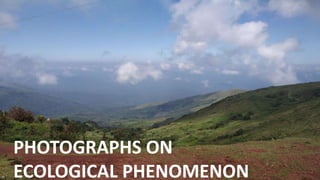The document discusses several ecological phenomena and concepts:
1) Weathering describes how rocks and minerals break down on Earth's surface due to water, ice, acids, salts, plants, animals, and temperature changes acting as agents of weathering over time.
2) Forest ecosystems are areas dominated by trees that consist of integrated communities of plants, animals, microbes, soils, and atmospheres. Forests maintain climate, rainfall, and support biodiversity.
3) Mountain ecosystems are found on mountain slopes and provide diverse habitats for many plant and animal species, though conditions are harsher at higher altitudes with alpine vegetation.











